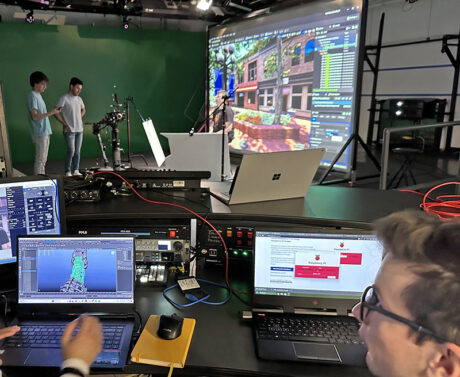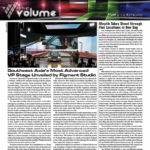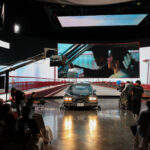
Nick Jushchyshyn, program director of Digital Media and Virtual Production at Drexel University’s Westphal College of Media Arts and Design, uses Blackmagic Design’s Ultimatte 12 HD and Ultimatte 12 HD Mini real time compositing processors as part of the program’s virtual production workflow, along with Blackmagic cameras, compositors, switchers, routers, and more for course work and teaching the latest production workflows.
Founded in 1891, Drexel University is a leading private research university based in Philadelphia, PA. Jushchyshyn directs the Virtual Production program, the Animation, Capture and Effects Lab (ACE-Lab) and the Immersive Research Lab (IRL). The ACE-Lab is the university’s hub for student learning and activities related to animation, visual effects (VFX), motion capture, 3D scanning, virtual reality (VR), augmented reality (AR) and a variety of other traditional and immersive forms of digital media. Along with various class, meeting and screening rooms, the lab also features a 40‘ x 40‘ studio with a 25‘ x 17‘ green screen cyclorama, motion capture system, studio lighting equipment, full dome immersive projection system, and room scale VR systems.
Ultimatte 12 HD
“We’ve used Blackmagic Design for many years as part of our volumetric, stereo photometric and stereo 360 VR systems, VFX courses related to green screen compositing, and 3D camera tracking courses. We’ve also used it for remote learning and streaming pre COVID,” noted Jushchyshyn. “However, I recently completely rebuilt the A/V architecture of the lab’s main teaching studio around Ultimatte 12 HDs, ATEM SDI switchers and more. The Ultimattes and ATEMs have been transformational for us.”
According to Jushchyshyn, Ultimatte 12’s affordability has allowed the nonprofit institution to invest in several units which it uses in a multitude of ways. “It’s truly a full featured compositing unit,” he said. “Virtual production interfaces real world video equipment with digital 3D technology, and we use tools like Unreal Engine and Ultimatte to teach the students these skillsets, since they are the same technology used in major sports broadcasts, network news and weather. We even use Ultimatte 12 HD Mini as a bidirectional interface for our HDMI Pocket Cinema Camera 4Ks, which we didn’t necessarily buy for live use, but can now bring into an SDI live virtual production space.”
He continued, “In addition to teaching the workflow and technology, I also personally use an Ultimatte to create my remote office for meetings, interviews, classes, etc. I have a Micro Studio Camera 4K and an Ultimatte 12 HD feeding into an ATEM Mini with the Ultimatte performing the key, which is fed into Unreal Engine. That creates a 3D environment that appears to be a full TV studio with a moving camera on a dolly track, but really, I’m sitting in a 9‘ x 9‘ closet space with green fabric behind me.”
ATEM SDI
Similar to Ultimatte 12, Jushchyshyn uses a variety of ATEM SDI and ATEM Mini live production switchers, noting that the capabilities are exemplary of what goes on in professional network studio production, but that the smaller size is a great introduction for students. “The ATEMs are very approachable, and everything the students learn becomes foundational for the future,” he noted. “Outside the classroom, students get hands on experience by working events, such as an end of year showcase, and managing live productions for the college both on campus and offsite.”
“We have an ATEM SDI Extreme ISO permanently installed in our standing lab, which is our main teaching studio,” Jushchyshyn continued. “Before the ATEM, there was no good way to document the motion capture classes without showing up hours in advance to set up extra gear, both for me as a teacher for remote learning and for the students recording their work for their portfolios to show future employers.” Jushchyshyn appreciates the ATEM SDI Extreme ISO’s eight inputs into which he feeds two ceiling mounted Micro Studio Camera 4Ks and two computers running motion capture software. The extra four inputs provide the flexibility to add video sources, such as a head mounted video camera facing the performer, witness and reference cameras, and more. The switcher’s four outputs are dedicated to monitors distributed throughout the space.
“The ATEM is fully featured,” he said. “The built in Fairlight suite of audio processors lets me configure the audio into the sweet spot for use in the studio, the dynamic range isn’t all over the place for the remote folks, and the recording is automatically attenuated for those watching later. I also love the SuperSource as it provides a polished look, and I can easily connect to Zoom via USB, use the ATEM with Ultimatte to replace green screen, and more.”
Jushchyshyn concluded, “The studio is incredibly powerful as a hybrid, all in one teaching space. Previously, I would have to coordinate all these disparate systems, but now I hit one button, and everything is ready to go. Blackmagic Design has made all that possible.”
This insightful content is from Blackmagic Design. Learn more about what this industry leading company offers at www.blackmagicdesign.com


